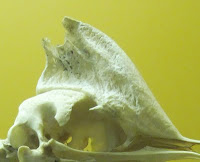I'm not sure a hall like this would be built nowadays - detailed anatomy guides may not seem as relevant as ideas about ecology, conservation, and evolution. It was also extremely low-tech, with not a single touch-screen, TV, or projection to be seen. But I was glad it was there, and I think it complemented the taxidermy dioramas and multimedia-intensive galleries.
Here are some close-ups from some of the photos I took – can you guess what animal each belongs to? Answers below!
------------------
1. Look closely – you’ll see the tiny arms of the brown kiwi (Apterix australis) alongside it’s egg-shaped body. I also had no idea kiwi ribs were so broad!
2. Quill knobs are prominent on the humerus of the brown pelican (Pelecanus occidentalis).
3. The powerful shoulders and large olecranon process should give you a clue: this is the arm of the giant anteater (Myrmecophaga tridactyla).
4. That fang looks like it should belong to a sabre-toothed cat, but it’s actually an Indian muntjac, Muntiacus muntjak, a small deer (amusingly labelled as a barking deer in the exhibit, which I suppose must be an older name).
5. The casque of the cassowary (Casuarius casuarius) is surprisingly spongy.
6. Those unusual rodent-life incisors belong to the aye-aye (Daubentonia madagascariensis).
7. This strangely bent neck belongs to the anhinga, Anhinga anhinga (anhinga anhinga anhinga...).









Boy, I did poorly. Only 2 out of 7. Fail.
ReplyDeleteMuntjacs were presumably named barking deer because they really do bark similarly to dogs! (There are a few recordings on Youtube, though I can't find one that shows the actual muntjac making the calls.)
ReplyDelete